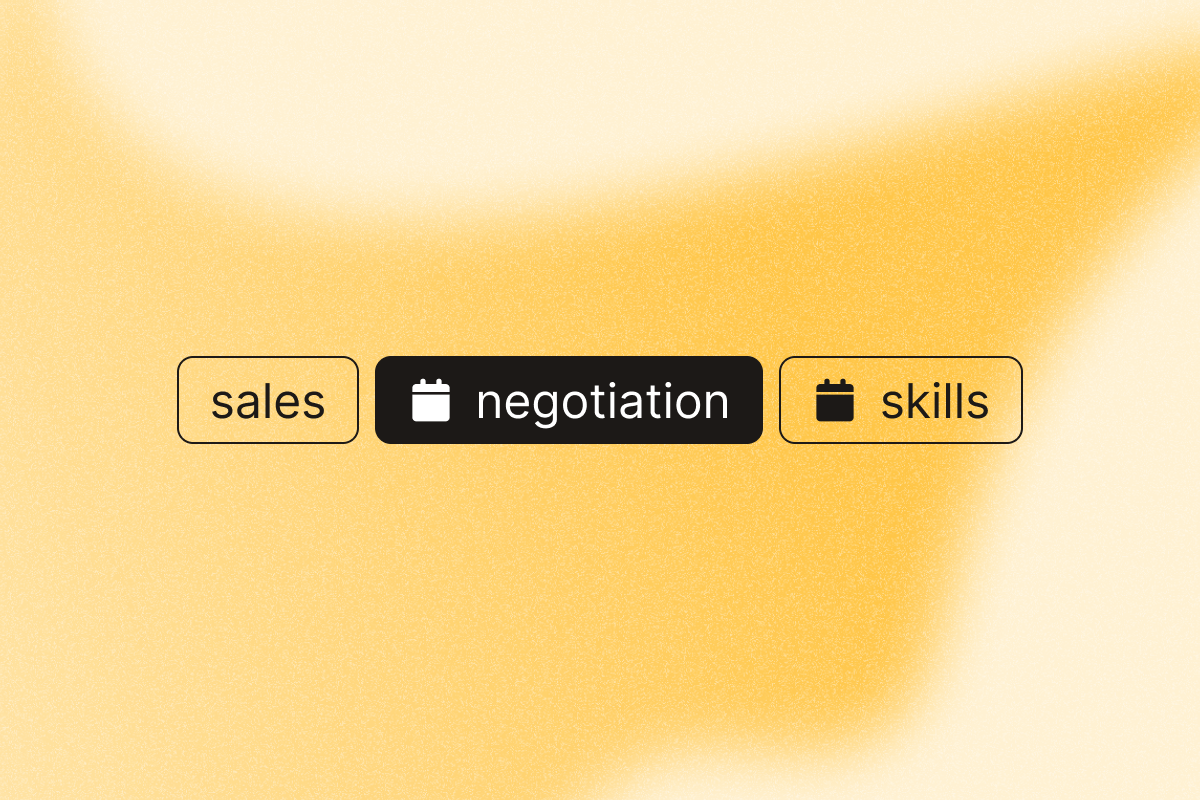The sales negotiation process can be intimidating at first. But with these negotiation techniques and resources, you can confidently approach every conversation.
What are sales negotiation strategies?
Sales negotiation is the part of the sales process where you aim to reach an agreement with your potential customer. And sales negotiation strategies are the communication tips that can help you get there!
Successful sales negotiation is like a dance between the seller (that’s you) and the buyer. Both sides have different goals: you want to make a profit, and the buyer wants a lower price.
The negotiation process helps to find a middle ground where both parties are happy. And once you achieve this win-win situation, it’s known as a “beneficial outcome”.
However, coming to the negotiation table can feel stressful for many sales professionals. Fortunately, there are plenty of effective negotiation techniques that can turn it into a piece of cake, with beneficial outcomes for everyone!
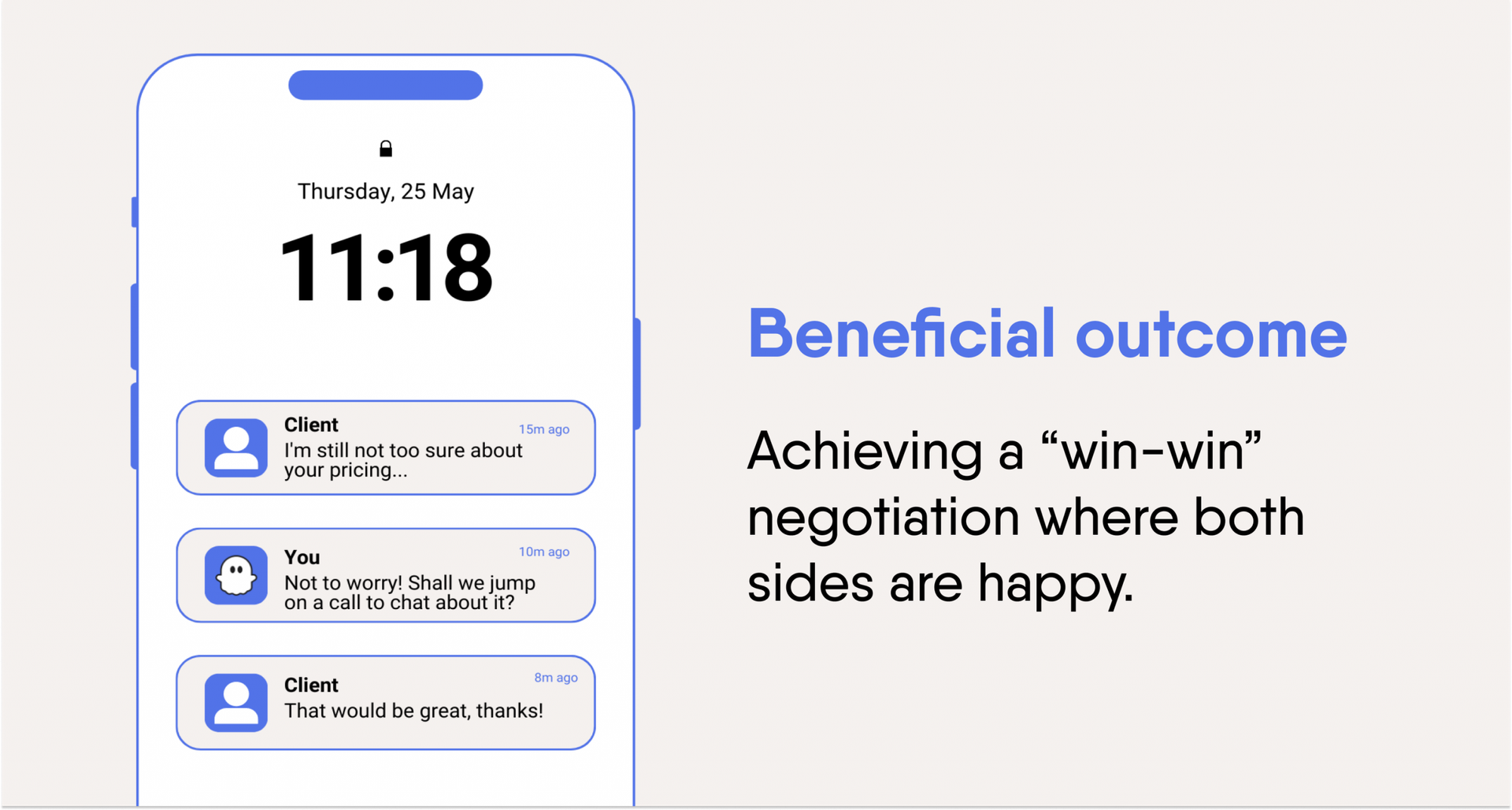
17 sales negotiation tactics to close more deals
Even a seasoned salesperson can experience nerves before a negotiation, and in the real world, not every conversation always goes according to plan. But the good news is that with these strategies, you can handle anything that comes your way.
Let’s break this down into several categories:
- How to behave during a sales negotiation
- How to handle the discussion
- What to do if the negotiation is unsuccessful
Check out this mind map for a quick overview, then we’ll dive into the tips in more detail.
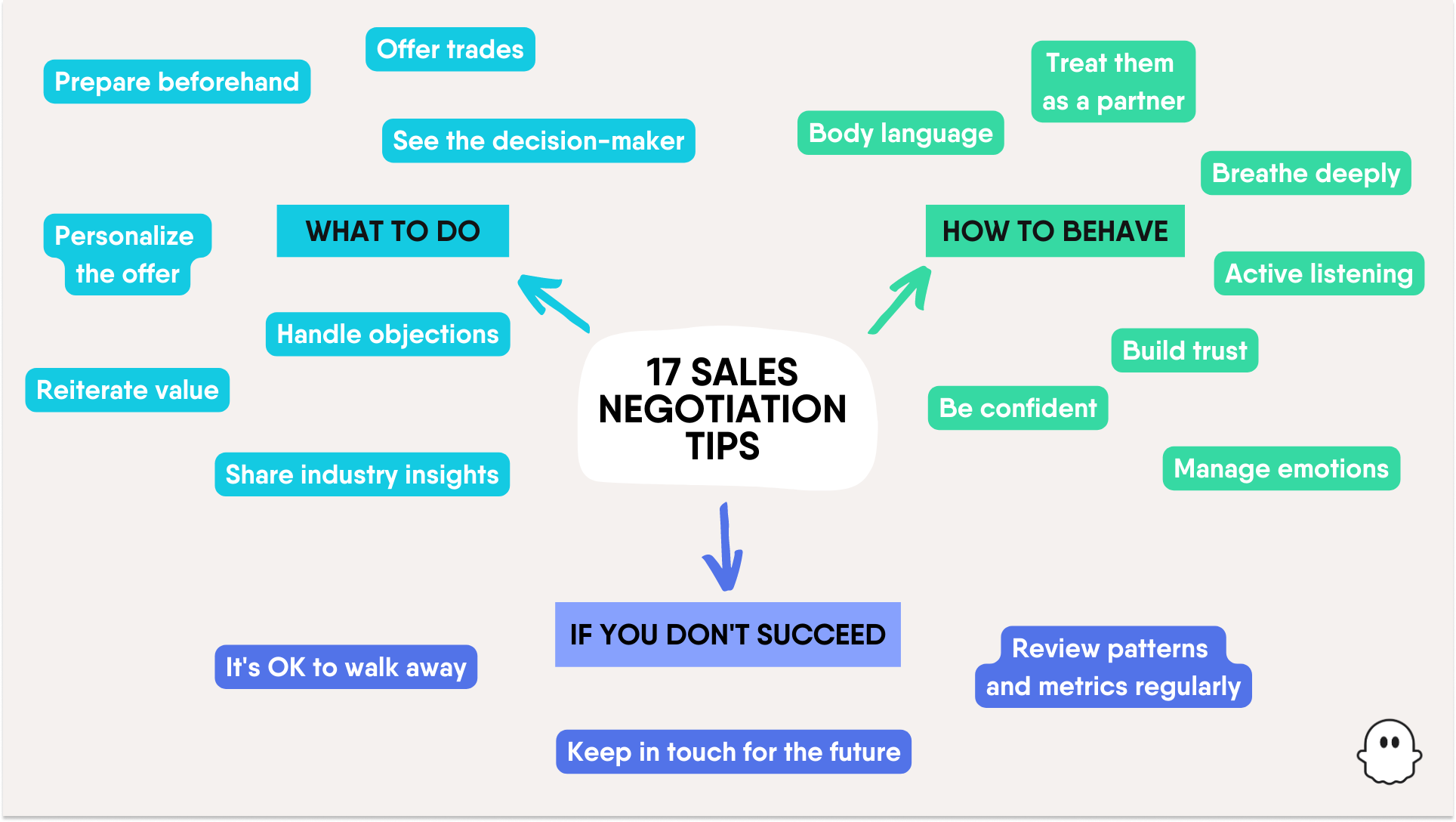
How to behave during a sales negotiation
Before you launch into the discussion, it’s important to make sure you come across the right way. Here are some simple tips to do that.
1. Take a deep breath
Before the negotiation, take a moment to breathe deeply and calm your nerves.
Remind yourself of your preparation, value proposition, and ability to handle the situation. Give yourself a mental boost and approach the negotiation with a clear mind.
Many breathing exercise apps, such as Headspace and Calm, can help you.
2. Think about your body language
Non-verbal cues like facial expressions, posture, and gestures play a big role in communication. Maintaining open and positive body language can help build rapport and show that you’re engaged and interested in the negotiation.
Nod your head occasionally to acknowledge understanding, smile when appropriate, and lean slightly forward to show interest. These cues encourage the speaker to continue sharing.
3. Build trust with the other person
Don’t be afraid to open the conversation with small talk before launching your sales pitch. This will build rapport and create common ground right away. When the negotiation starts, be honest, stay transparent, and keep any promises you make.
4. Use your active listening skills
When negotiating, listening to the other person’s needs and concerns is crucial. Here’s how to do that:
Be fully present: Give your undivided attention to the person speaking. Put away any distractions, such as your phone.
Maintain eye contact: Eye contact conveys respect and shows that you’re actively engaged in the conversation.
Avoid interrupting: Let the speaker finish their thoughts before responding. Interrupting can disrupt their flow and make them feel unheard.
Paraphrase and summarize: To demonstrate that you’re truly listening, paraphrase or summarize what the speaker has said in your own words.
Ask open-ended questions: Encourage the speaker to expand on their thoughts by asking open-ended questions that can’t be answered with a simple “Yes” or “No”.
Reflect on emotions: Pay attention not only to the words but also to the speaker’s emotions and feelings.
Avoid judgment and assumptions: Keep an open mind to truly understand the speaker’s viewpoint.
Be patient and give space: Some people need a little extra time to gather their thoughts and express themselves. Be patient and avoid rushing or pressuring the speaker.
Show interest through verbal cues: Use verbal cues to demonstrate your engagement. Offer encouraging statements like “I see”, or “Tell me more.”
5. Control your emotions
During the negotiation process, there will likely be moments when you do not agree with the other person. When this happens, the conversation can easily turn into an argument!
Instead, stay grounded. Convey a sense of calm through your body language, and keep your voice light, friendly, and positive. This will defuse any tension and keep you from getting flustered.
6. Treat the other person like a partner, not a customer
You want the other person to feel like you’re on an equal footing. Instead of visualizing them as another “lead”, think of them like a work partner or colleague.
Then, focus on how you can collaborate to address their pain points and achieve their goals. This will make the negotiation feel less like a confrontation and more like a collaboration.
7. Trust yourself
Remember that you’re an expert in what you’re selling. Have confidence in your knowledge and expertise. Believe in the value of your product or service, and let that confidence shine through. Your enthusiasm and belief will inspire trust in the other person.
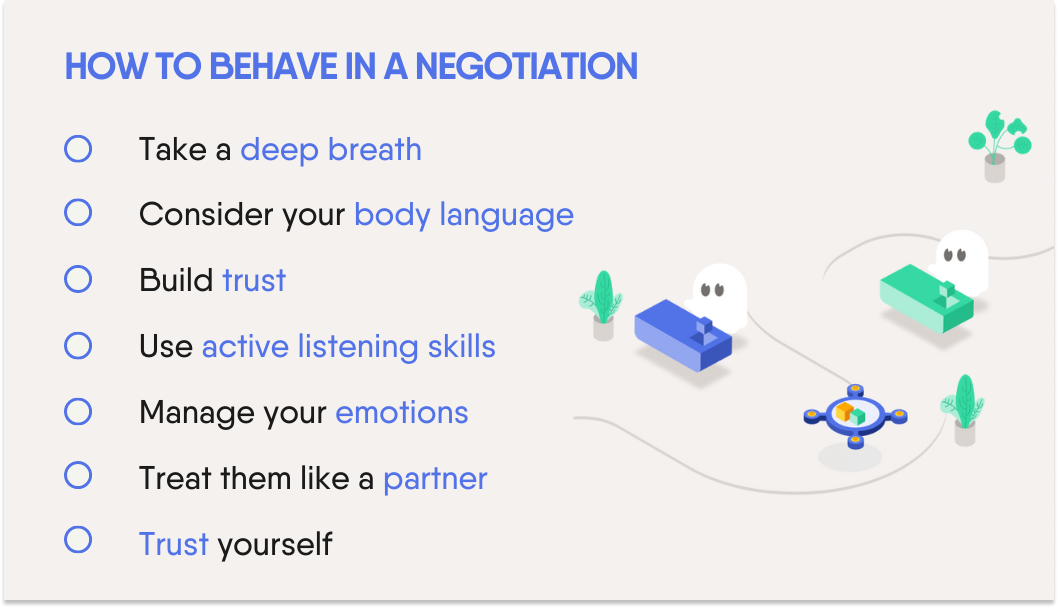
How to handle the discussion
Now, let’s explore the conversation itself. There are several sales tips and structures to lead the discussion in the right direction.
1. Be prepared
Before you start the negotiation, take the time to thoroughly prepare for the negotiation. Research the other party’s needs, understand your product or service inside out, and anticipate potential objections or questions. The more prepared you are, the more confident you’ll feel during the negotiation.
2. Speak to the right decision-maker
When it comes to decision-making, you must be sure that the person you’re talking to is authorized to make the final call on whether to buy or not. Otherwise, you’ll lose time presenting your sales pitch to the wrong person.
One way to be sure is to run a filtered search on LinkedIn, such as “CTO in [company],” and check the results. This can help you narrow down the right person.
Bonus tip: Find the right decision-maker’s email on autopilot
At PhantomBuster, we’ve created a Flow (automation sequence) that takes profiles from a LinkedIn search URL, and then automatically searches for their emails. So if you need to reach the right people at scale, the LinkedIn Search to Emails Flow was designed for you.

3. Tailor your first offer to their needs
The first offer you make in your sales pitch sets the tone for the negotiation. It’s important to research and understand the value of what you’re selling and the other person’s needs, payment terms, and budget. Aim for a reasonable first offer that leaves room for negotiation but also shows the value of your product or service.
4. Handle objections
When you get an objection (where someone doesn’t see the value of what you’re offering), remember that this is normal! Approach their concerns and pain points with empathy and a problem-solving mindset.
Validate their feelings and show that you understand their perspective. Then, focus on sharing relevant information and alternative solutions. When handled well, objections can help, not hinder, the negotiation process.
5. Consider offering trades
For your pricing strategy, it is better not to concede right away. However, you could consider trades, offering something for mutual gain. For example, you might offer a bigger discount, in exchange for a longer subscription to your service—giving you a long-term client.
6. Remind them what they will lose
If they’re still sitting on the fence, it’s OK to gently remind them of what their life will look like without your product or service. This could help to nudge them towards sealing the deal with you. It also reminds them of why they entered your sales cycle in the first place.
7. Share third-party knowledge to back up your proposal
To avoid appearing overly biased towards your brand, you could always share industry trends and statistics. These metrics can back up your sales pitch, and present you as an authority in your niche.
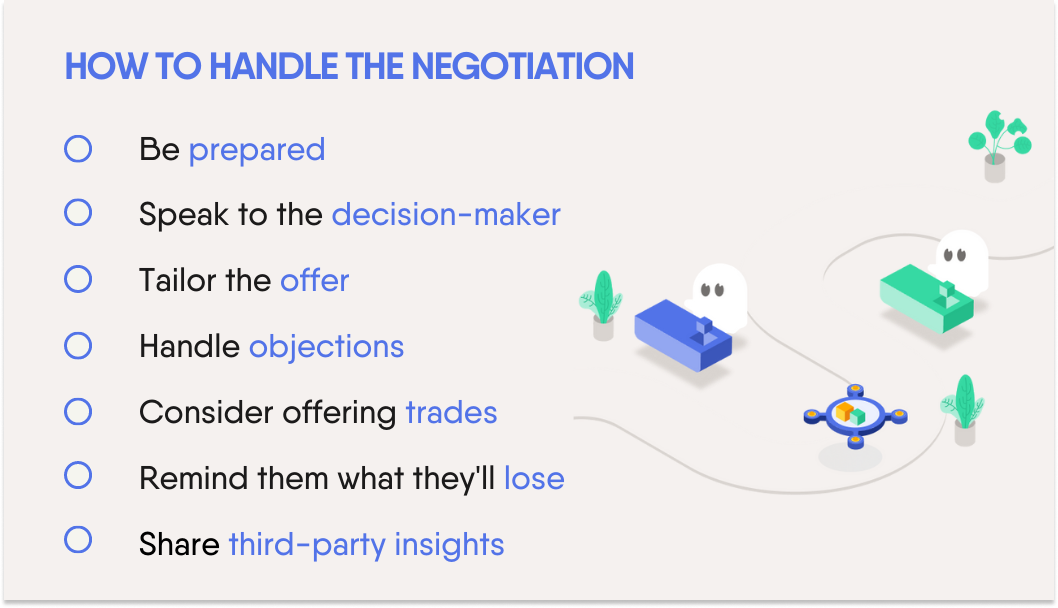
What to do after an unsuccessful negotiation
Despite our best efforts, not every negotiation will end in success. This is not a reflection of you or your sales organization; it’s simply a part of being in the real world! Here’s what to do when it happens.
1. Know that it’s OK (even good!) to walk away
Maybe you just weren’t a right fit, this time. Or perhaps it wasn’t the right timing for your prospect. Either way, you should never try to force an unprofitable deal through. It’s far better to take a step back and let the prospect return to you if they change their minds.
2. Keep in touch for the future
If the deal didn’t happen this time, take a long-term view. Maintain a good relationship with your lead after the negotiation. Perhaps you might send them a friendly follow-up email afterward or like and comment on their LinkedIn posts from time to time. This will keep you in mind; one day, they might be back.
Bonus tip: Engage with LinkedIn posts on autopilot
Scrolling through your phone can be a time drain. Fortunately, the LinkedIn Auto Liker Phantom can automatically like people’s posts for you! This means that your name will keep popping up in their notifications again and again.
And if you want to go one step further, you could also try the LinkedIn Auto Commenter Phantom to leave thoughtful, pre-written comments, too.
3. Review patterns and metrics in your CRM workflows
Finally, keep an eye on your metrics in your CRM. Look out for any patterns. For example, if there is a certain buyer persona that regularly drops off after a certain point in your sales workflow, then maybe it’s time to review your sales strategy. Perhaps you need to adapt your process to suit them better, or to target a different ideal customer profile.
Bonus tip: Add your PhantomBuster results to your CRM
With PhantomBuster, you can gather hundreds of leads on autopilot—and then connect the results with your CRM.
Here are several Phantoms which can connect your results with your CRM. Click on them for more detailed information and tutorials—then try them for yourself!
- HubSpot CRM Enricher Phantom: Import your data to HubSpot
- Salesforce CRM Enricher Phantom: Send your leads to Salesforce
- Pipedrive CRM Enricher Phantom: Upload your prospects to Pipedrive

3. Sales negotiation training programs and resources
Finally, sales leaders and beginners can always benefit from sales negotiation skills training! Here’s a quick list of resources, online training, and tools to help you stay on top of your negotiation game.
- Pipedrive blog: “Sales negotiation training, skills and strategies to win more deals”
- HubSpot Academy: “Free sales manager training: Strategies for developing a successful modern sales team”
- Salesforce blog: “How to get the most out of a sales call”
- PhantomBuster blog: “60 sales resources you’ll wish you knew yesterday”
You can also have role-playing activities with your sales team to practice your in-person negotiation skills.
Also, take a look at case studies from previous negotiations, and see what you can learn from them. It just might influence your methodology in the future.
As a bonus resource, look at Pipedrive’s handy guide to overcoming objections in sales…
A new way to harness your leads
PhantomBuster is a lead generation automation software, designed to help you streamline your sales workflows and save time to focus on what matters.
It operates over 100+ Phantoms (automations) and Flows (sequences), from finding emails on LinkedIn, to auto-commenting on Instagram.
